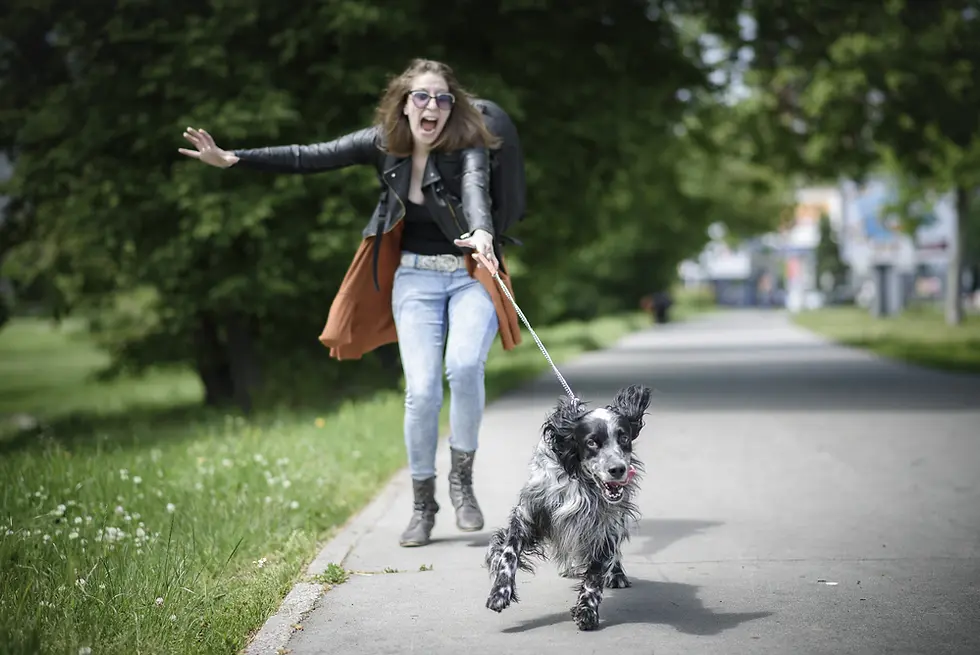Some dogs do not have leash etiquette. This is not because they are misbehaving it is because they have learnt that pulling makes them go forward - the intended reward for the action. You cannot assume your dog will immediately learn not to pull, and the more you allow it the more they see it as a reward. If you would like to have your dog walk calmly by your side you will need to retrain their brain that being next to you is more rewarding than pulling.

You will first need to know how to hold the leash to ensure you have the appropriate balance and control. Use your core to centre yourself with elbows bent and tucked into your sides. As soon as you lose balance and stumble forward when they pull, you are teaching them that pulling creates even the slightest forward motion to get what they want to reach faster[1],[2].
In your home, start the training with “sit” and then build in the leash into it. Have the leash be the cue to sit when presented to your dog and reward with praise and treats[3]. Once your dog is comfortable with the leash, you may begin placing the leash on them after they sit, treat once this is done. After enough practice, you may begin walking around with them on lead. Don’t leave too much room for pulling when walking if your dog. If your dog is roughly a ruler length away from you, they can still see you in their peripherals and thus you are still on their radar – if they cannot see you they may not be paying attention to you.
When you begin training, reward your dog very regularly when they stay at your side or if they look up at you, even if just briefly. Make sure you start in an area with minimal distractions and only increase distractions as your dog shows consistency in walking. If your dog is pulling, you are likely not rewarding them enough to stay by your side. Be consistent in only rewarding them when they are at your side. Make sure they get to the stage that they want to be walking loosely on the leash at your side and build in a cue (i.e. “heel”). Slowly distance the time between treats and start to randomise when they get them so they learn that a reward could come at any time and enjoy loose leash walking. Move the treat to your other hand to fade out the lure (hide the treat), and put your empty hand by your side as a hand signal to get them to stand by your side – treat with your other hand as a reward. You can then evolve this into praise rather than treats every now and then.
Another effective training method is to teach your dog “about turn”, an abrupt 180 degree turn to go the other way. With your dog at your side, reward them with treats for walking well, then abruptly turn, rewarding them if they follow your turn. This will teach your dog that you are unpredictable and needs to pay close attention to you[4].
Keep training sessions short, roughly ten minutes, so your dog doesn’t get tired and give them regular sniffing breaks in between walks.
Be careful not to treat your dog as soon as the leash slacks after a pull, wait a bit before treating – otherwise they will learn that pulling and then walking at your side will lead to treats.
This training requires a combination of positive reinforcement for walking on a loose leash and stopping (without jerking or showing emotion) when they try and pull. When you stop walking as they pull, you are not causing them any pain but you are telling them that pulling stops forward motion – make sure to be consistent and stop forward motion every time.

[1] Arthur, N. 2014. Loose-Leash Walking: Part One. Available from: https://www.clickertraining.com/loose-leash-walking-part-one#:~:text=%22Build%20good%20foundation%20behaviors%2C%22,of%20building%20a%20sturdy%20house.&text=Loose%2Dleash%20walking%20is%20just,rest%20should%20fall%20into%20place. (Accessed 20 April 2021) [2] Cold Nose Lodge. 2019. Loose Leash Walking: How to Stop Pulling. Available from: https://www.coldnoselodge.com/2019/04/18/how/ (Accessed 20 April 2021) [3] Summers, K. 2019. Leash Training With Positive Reinforcement. Available from: https://summerbrookgoldens.com/stop-leash-pulling-with-positive-reinforcement/ (Accessed 20 April 2021) [4] London, L. 2018. Loose Leash Walking: An Expert Guide to Getting a Relaxing Stroll. Available from: https://thehappypuppysite.com/loose-leash-walking/ (Accessed 20 April 2021)

Comments